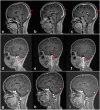Analysis of 10 Pediatric Nephrotic Syndrome Cases With Complications of Cerebral Sinovenous Thrombosis
- PMID: 33425818
- PMCID: PMC7786383
- DOI: 10.3389/fped.2020.607776
Analysis of 10 Pediatric Nephrotic Syndrome Cases With Complications of Cerebral Sinovenous Thrombosis
Abstract
Background: To analyze the clinical characteristics of nephrotic syndrome (NS) with complications of cerebral sinovenous thrombosis (CSVT) in children. Method: Clinical, radiographic, laboratory, and treatment data obtained from 10 confirmed cases of NS with complications of CSVT were analyzed. All patients were followed up for at least 18 months. CSVT was diagnosed by cerebral computed tomography (CT) and/or magnetic resonance imaging (MRI) with or without magnetic resonance venography (MRV) of the cerebral vessels. Results: Among 10 cases reported, 4 were steroid-sensitive NS with frequent relapse, 5 were steroid-resistant (three of them had renal biopsies showing two minimal change disease and one IgA nephropathy), and 1 was steroid-sensitive with one relapse. Common clinical manifestations were headache or ophthalmodynia complicated by vomiting, dizziness, convulsion, and coma. Neuropathologic signs were positive in some cases. Papilledema appeared in only one case with winding of vein. Cerebrospinal fluid was examined in three cases with elevated pressure but normal cytological and biochemical results. D dimer and fibrinogen levels were elevated while prothrombin time and activated partial thromboplastin time were shortened. Five out of seven cases who had performed cranial CT were suspicious for cerebral thrombosis. Nine cases had cranial MRI with abnormal signs in seven cases. All of the cases received MRV, confirming the diagnosis of CVST. Conclusion: Clinical manifestations of NS with CSVT are not specific but varied. Therefore, CSVT should be considered once nervous manifestations present. MRV is a better method in the diagnosis of CSVT.
Keywords: cerebral sinovenous thrombosis; children; complication; magnetic resonance venography (MRV); nephrotic syndrome.
Copyright © 2020 Rong, Chen, Dong, Zhuang, Lin, Mo and Jiang.
Conflict of interest statement
The authors declare that the research was conducted in the absence of any commercial or financial relationships that could be construed as a potential conflict of interest.
Figures


Similar articles
-
Cerebral sinovenous thrombosis in children with nephrotic syndrome: systematic review and one new case.Front Pediatr. 2023 Aug 24;11:1207871. doi: 10.3389/fped.2023.1207871. eCollection 2023. Front Pediatr. 2023. PMID: 37691772 Free PMC article. Review.
-
Cerebral sinovenous thrombosis in a child with idiopathic nephrotic syndrome.Case Rep Nephrol. 2011;2011:724950. doi: 10.1155/2011/724950. Epub 2011 Nov 30. Case Rep Nephrol. 2011. PMID: 24533195 Free PMC article.
-
Analysis of 6 pediatric nephrotic syndrome cases with complications of cerebral sinovenous thrombosis and literature review.Front Pediatr. 2023 Sep 11;11:1226557. doi: 10.3389/fped.2023.1226557. eCollection 2023. Front Pediatr. 2023. PMID: 37753194 Free PMC article.
-
Magnetic resonance venography to evaluate cerebral sinovenous thrombosis in infants receiving therapeutic hypothermia.Pediatr Res. 2023 Mar;93(4):985-989. doi: 10.1038/s41390-022-02195-5. Epub 2022 Jul 19. Pediatr Res. 2023. PMID: 35854084
-
Cerebral sinovenous thrombosis (CSVT) in children: what the pediatric radiologists need to know.Radiol Med. 2016 May;121(5):329-41. doi: 10.1007/s11547-016-0630-9. Epub 2016 Mar 30. Radiol Med. 2016. PMID: 27025499 Review.
Cited by
-
American Society of Hematology/International Society on Thrombosis and Haemostasis 2024 updated guidelines for treatment of venous thromboembolism in pediatric patients.Blood Adv. 2025 May 27;9(10):2587-2636. doi: 10.1182/bloodadvances.2024015328. Blood Adv. 2025. PMID: 40423983 Free PMC article.
-
Cerebral sinovenous thrombosis in children with nephrotic syndrome: systematic review and one new case.Front Pediatr. 2023 Aug 24;11:1207871. doi: 10.3389/fped.2023.1207871. eCollection 2023. Front Pediatr. 2023. PMID: 37691772 Free PMC article. Review.
References
LinkOut - more resources
Full Text Sources
Miscellaneous

